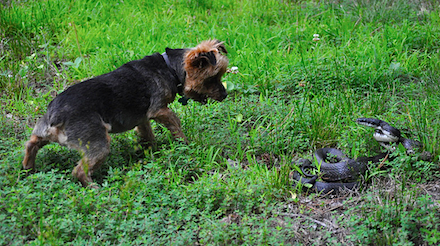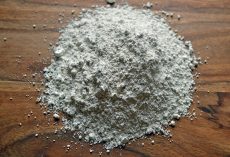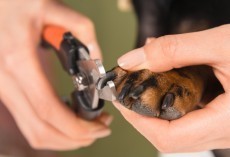It’s always a good idea to be prepared. When hiking with your dog, if you are unfamiliar with the area, you might want to seek advice from friends and acquaintances on what predatory animals are about. And, of course, if there are snake in the area.
If there are snakes what type inhabit the area? Are they venomous?
Four species of venomous snakes are indigenous to the United States:
1.Copperheads
2.Rattlesnakes
3.Cotton mouths/water moccasins
4.Coral snakesThe most common venomous snakes in the United States are crotalidae — copperheads, cotton mouth/water moccasins and rattlesnakes — also referred to as pit vipers. These snakes prefer to live in tall grass, along ponds, streams and marshes, and in rock and wood piles. They are somewhat nocturnal and they love cool, dark dens.
Crotalidae have broad triangular heads with elliptical pupils. Their curved fangs are prominent, and they are marked by a deep “pit” between the eyes and the nostrils — hence the name pit viper. Experts estimate the bite of the pit viper accounts for around 99 percent of snakebites to dogs. Very painful but rarely fatal, the toxicity of the bite of a pit viper depends on the type, age and size of the snake; the amount of venom injected; and the age, size and relative health of the animal bitten.
Rattlesnake Warning Signs
• Sudden yelp of pain, especially if your dog is playing in a potentially infested area
•Rapid swelling on the legs or face
•Apparent, intense pain
•Fang/puncture marks
•Oozing blood at puncture
•Drooling
•Rapid breathing
•Dilated pupils
•Pale gums
•Weakness
•CollapseTreating a Rattlesnake Bite on a Dog
Stay calm. If possible, identify the kind of snake responsible for the bite. Restrict your dog’s activity — this will reduce the effect of the venom. Seek immediate veterinary treatment. Your vet can determine the amount of toxicity injected by the reaction of your dog and/or blood tests.If a veterinarian is not immediately available:
•Administer diphenhydramine, an antihistamine such as Benadryl, to reduce the allergic reaction from the snake bite.
•If the bite was to the throat, temporary airway support may be necessary.
•Medication for pain should be administered.
•Medication for infection will be necessary.
Seek professional medical treatment as soon as possible. Recovery will depend on response time and treatment. Most dogs survive crotalidae bites with few if any complications.Elapidae – Coral Snakes
Coral snakes have very distinct red, yellow and black color patterns. Like all elapine snakes, they have short fangs and “chew” venom into their victims. The venom is neurotoxic and paralyzes the respiratory system. Bites from elapine snakes are very dangerous and often fatal.
As with crotalidae snakes, diagnosis is often difficult to determine unless the attack is witnessed. Knowledge of the area and the potential for coral snake infestation is crucial.Coral Snake Warning Signs:
•Drooling
•Vomiting
•Diarrhea
•Weakness
•Disorientation
•Difficulty breathing
•ParalysisTreating a Coral Snake Bite on a Dog:
•Seek medical assistance immediately.
•Restrict your animal’s movement, and keep him calm and quiet.
•DO NOT apply a tourniquet.
•DO NOT attempt to suck the venom out.
•Hospitalization may be required.
This may seem a little scary but if you educate yourself regarding the area where you plan to hike and walk the dog, as well as have a little knowledge about snakes, you can probably avoid the areas were poisonous snakes slither about.
If you are going for a walk make certain you are leashing your dog. In this case it probably is not optional simply because, God love ‘em, our pups do not see the potential harm in the outdoors that their masters do.
If you would like to know more about emergency procedures and further information about your pets and snake bites please go to the Pets Advisor With a little care and a watchful eye, scoping out a potential slither, you and your dog can get out and have a terrific Summer outdoors!









